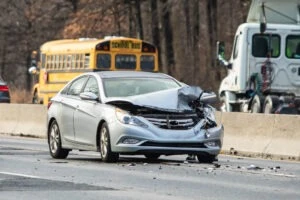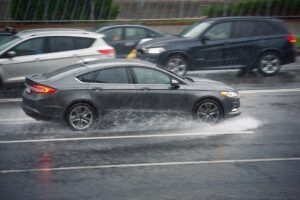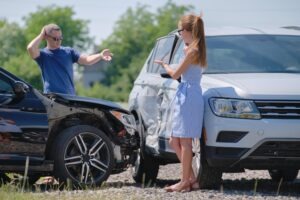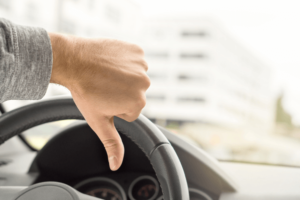
If you’re involved in a crash, your priority should be to get your vehicle to a safe location as quickly as possible. You don’t want to risk causing another accident or putting yourself or others in harm’s way. So, where should you stop? Ideally, you’ll find a spot away from traffic, like a roadside, parking lot, or wide shoulder.
You can take further steps to alert others of the accident including using your hazard lights and lighting road flares. The more you can do to prevent further harm the better.
After an accident, an experienced Fort Lauderdale car accident lawyer can help you recover damages for any injuries or other losses you incurred.
Move to a Safe Location
If you’re involved in a crash, your priority is to move to a safe location to avoid further danger. This is a vital step in the accident protocol, as it helps prevent additional accidents and reduces the risk of injury. When moving to a safe location, consider the vehicle positioning to make sure you’re not obstructing traffic or creating a hazard.
If possible, move your vehicle to the side of the road, a parking lot, or a wide shoulder. This will give you a safe space to assess the situation and exchange information with other parties involved. Remember, your safety is paramount, so take the necessary steps to protect yourself and others.
More people choose The Schiller Kessler Group because they know that we’re a cut above other personal injury law firms.

Avoid Stopping in Traffic Lanes
Avoiding stopping in traffic lanes can be essential as failure to do so can lead to secondary accidents and put you and others at risk. You’ve already been through a traumatic experience, and you don’t want to increase the chances of another accident occurring.
Stopping in traffic lanes compromises road safety and reduces traffic awareness, making it challenging for other drivers to navigate the area.
Instead, try to move your vehicle to the side of the road, a parking lot, or a wide shoulder. This will give you and others a safer space to assess the situation and exchange information.
By doing so, you’ll be taking an essential step in preventing further accidents and promoting a safer environment for everyone involved.
Use Hazard Lights and Signals
You’ve moved your vehicle to a safe location, now it’s time to alert other drivers to the situation. It’s vital to prioritize hazard awareness and signal usage to prevent further accidents or collisions.
To help ensure your safety and the safety of others, remember to:
- Turn on your hazard lights to signal that your vehicle is stopped or disabled.
- Use your turn signals to indicate your intentions to other drivers.
- Consider using road flares or reflective triangles to increase visibility, especially at night or in low-light conditions.
- Keep your vehicle’s lights on, even during the day, to increase its visibility to other drivers.
Be Aware of Road Conditions
As you regain composure after a crash, take a moment to assess the road conditions around you. You need to take into account the weather effects and road surface to ensure your safety and the safety of others. Steps to take include:
- Check for slippery or uneven road surfaces that could cause further accidents or make it difficult for emergency responders to reach you.
- Be aware of weather conditions like heavy rain, fog, or snow that could reduce visibility or make the road hazardous.
- Look out for any road debris or obstacles that could cause additional damage or pose a risk to others.
- Take into account the road’s slope or grade, as stopping on an incline could cause your vehicle to roll or slide.
Prioritize Visibility and Space
When you’re involved in a crash, it’s essential to prioritize your visibility and space to avoid further risks. You should move your vehicle to a safe zone, away from traffic lanes, to prevent additional collisions or disruptions.
By using warning triangles and positioning your vehicle strategically, you can create a buffer zone that protects you and others from potential dangers.
Move to Safe Zone
If you’re involved in a crash, your first priority is to move to a safe zone, where you’re not at risk of being hit by other vehicles or putting others at risk. This is an essential step in vehicle safety and crash protocol. Moving to a safe zone helps prevent further damage or injuries.
- Move your vehicle to the side of the road, away from traffic, if it’s safe to do so.
- Turn off the engine and engage the parking brake to prevent the vehicle from moving.
- Activate your hazard lights to alert other drivers to the situation.
- If you’re unable to move your vehicle, turn on your hazard lights and wait for assistance.
Avoid Traffic Lanes
Moving to a safe zone involves more than just getting out of the way of traffic; it requires prioritizing visibility and space to secure your safety and the safety of others. When positioning your vehicle, avoid traffic lanes altogether, as they can be hazardous even when you’re stopped.
Instead, look for areas with good visibility, such as the shoulder, a parking lot, or a wide sidewalk. This will help prevent further accidents and ensure traffic safety.
If possible, position your vehicle at an angle to create a buffer zone between your car and moving traffic. By doing so, you’ll create a safer environment for yourself and others while you wait for assistance.
Use Warning Triangles
After positioning your vehicle in a safe zone, deploy warning triangles to maximize visibility and create a safe buffer between your vehicle and oncoming traffic. This is vital for road safety awareness, as it prevents other accidents from occurring. When placing warning triangles, consider the following:
- Place them in a triangular formation around your vehicle, about 10-15 feet away from the vehicle.
- Make certain they are visible from a distance, especially at night or in low-visibility conditions.
- Position them on a level surface, away from any obstacles or hazards.
- Check local regulations for specific guidelines on warning triangle placement.
Get Help from an Experienced Car Accident Lawyer Today
If you’re involved in a crash, prioritize your safety above all. Move your vehicle to a safe location, away from traffic, and activate your hazard lights to alert others. After removing yourself from harm’s way and alerting emergency services of the accident, reach out to the experienced legal team at The Schiller Kessler Group for assistance.
In the event of a crash, it is crucial that you take the necessary precautions to ensure your safety and the safety of others. To discuss your case, contact us for a free case review.
Injured? Call The Aggressive Attorneys Today





